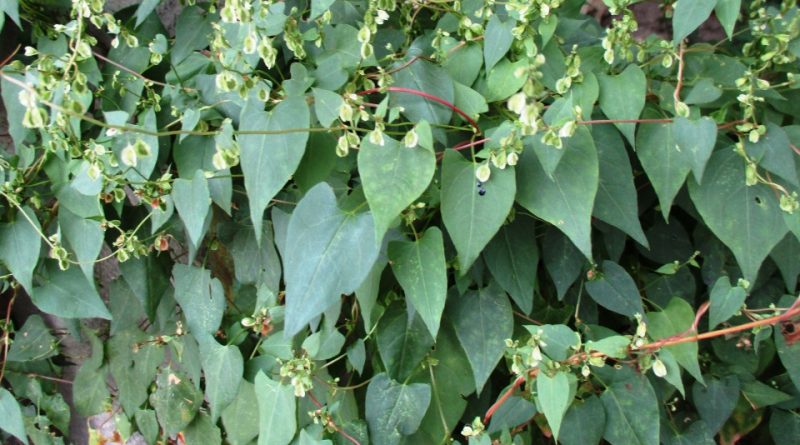Fallopia dumetorum
Fallopia dumetorum
The copse bindweed (Fallopia dumetorum (L.) Holub) is an annual herbaceous species belonging to the Polygonaceae family.
Systematics –
From a systematic point of view it belongs to:
Eukaryota Domain,
Kingdom Plantae,
Subarign Tracheobionta,
Magnoliophyta Division,
Magnoliopsida class,
Subclass Caryophyllidae,
Polygonales Order,
Polygonaceae family,
Genus Fallopia,
F. dumetorum species.
Basionimo is the term:
– Polygonum dumetorum L ..
The terms are synonymous:
– Bilderdykia dumetorum (L.) Dumort .;
– Bilderdykia pauciflora (Maxim.) Nakai;
– Fagopyrum dumetorum (L.) Schreb .;
– Fagopyrum membranaceum Moench;
– Fagopyrum pauciflorum (Maxim.) Gross;
– Fallopia pauciflora (Maxim.) Kitag .;
– Helxine dumetorum (L.) Raf .;
– Polygonum alatum Dulac;
– Polygonum convolvulus pauciflorum (Maxim.) Vorosch .;
– Polygonum pauciflorum Maxim .;
– Polygonum scandens dumetorum (L.) Gleason;
– Reynoutria scandens dumetorum (L.) Shinners; –
– Tiniaria dumetorum (L.) Drejer;
– Tiniaria pauciflora (Maxim.) Nakai.
Etymology –
The term Fallopia of the genus was dedicated to Gabriele Fallopio (1523-1562), an Italian anatomist.
The specific epithet dumetorum is the plural genitive of dumetum bush: of bushes.
Geographic Distribution and Habitat –
Fallopia dumetorum is a plant native to temperate Eurasia, present throughout Europe, central and western Asia up to western Siberia, Mongolia, the far east of Russia, northern China and Korea.
In Italy it is present in all regions except Sardinia.
Its habitat is that of hedges and at the edge of thermophilic deciduous broad-leaved woods, on fresh clayey soils, rich in nitrogen compounds, from sea level up to 2,400 meters.
Description –
The copse bindweed is an annual climbing plant with twining stems up to 150 cm long that branch freely at the base. It climbs the ground by twisting itself in the surrounding vegetation to support itself.
It has alternate leaves, palminervie, with stipules.
The flowers are bisexual and have an external envelope (calicetto). The chalice has 5 divisions, it has 5 petals, with twisted prefoliation, which alternate with the divisions of the chalice. It has many stamens with the filaments welded into a tube at the bottom.
The antesis is, depending on the latitude and altitude in which it grows, between May and September.
The fruit is a diclesium with 2.5-3.5 mm achene, ellipsoid, trine, black, smooth, shiny, included in the persistent perianth.
Cultivation –
Fallopia dumetorum is an annual climbing plant that is harvested in nature for local use as a food and medicine.
It is a plant that normally grows spontaneously but can also be grown in soils that are not too fertile, which in any case have good water retention and with sunny or partial shade exposure.
However, it should be remembered that it is a calcium-loving and nitrophilous species, widespread in bushes, meso-thermophilic shrubs, willow shrubs on the shore, in the vicinity of water courses, alluvial shores, gravels.
Propagation occurs by seed, with sowing to be done in spring. It has an excellent percentage of germination and, if sown in seedbeds, it should be transplanted in late spring – early summer.
Customs and Traditions –
Fallopia dumetorum is a plant that has been used, especially in the past, as plants for food and medicine.
For food use, both raw and cooked leaves are used.
Even the seed, like plants of the same family, should be edible even if there is no detailed information about it. However, its use has most likely been limited due to its small size.
In the medicinal field, the plant has been used as a purgative.
The little information on the use of this species leads to the hypothesis that the whole plant is used.
Preparation Method –
Fallopia dumetorum belongs to that genus of plants widely distributed throughout the world but little used, at least in recent times.
However, this plant has certainly been used for both food and medicinal purposes.
In the kitchen you can use both raw and cooked leaves.
In the medical field it seems that the whole plant is used, of which both decoctions and infusions could be used.
Guido Bissanti
Sources
– Acta Plantarum – Flora of the Italian Regions.
– Wikipedia, the free encyclopedia.
– Useful Tropical Plants Database.
– Conti F., Abbate G., Alessandrini A., Blasi C. (ed.), 2005. An annotated checklist of the Italian vascular flora, Palombi Editore.
– Pignatti S., 1982. Flora of Italy, Edagricole, Bologna.
– Treben M., 2000. Health from the Lord’s Pharmacy, Advice and experiences with medicinal herbs, Ennsthaler Editore.
Warning: Pharmaceutical applications and alimurgical uses are indicated for informational purposes only, they do not represent in any way a medical prescription; therefore no responsibility is taken for their use for curative, aesthetic or food purposes.


